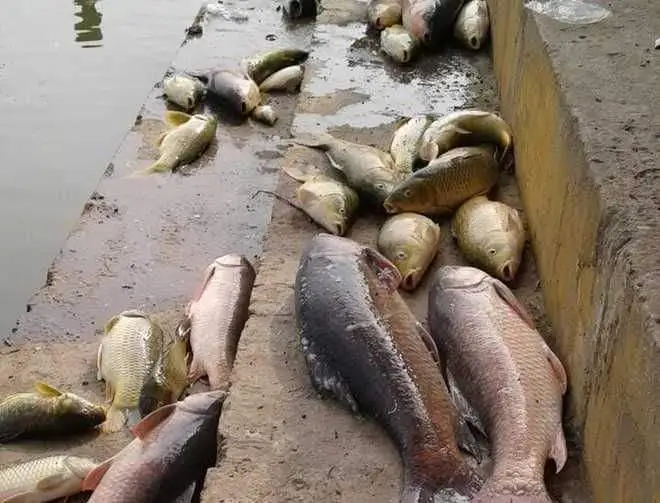Sajad Hameed | Srinagar
The iconic Dal Lake in Srinagar has witnessed a tragic event as thousands of fish were discovered lifeless, prompting concerns among residents.
While scientists attribute the mass death to thermal stratification, some residents are pointing fingers at the authorities, blaming the unscientific and unregulated cleaning of the lake in preparation for the G20 meeting.
In the days leading up to the G20 meeting held between May 22-24, local residents near the lake reported the sight of numerous dead fish floating on the water’s surface. The cleaning activities conducted to enhance the lake’s appearance for visitors, particularly the removal of vegetation and weeds, have been cited as potential causes by the residents. The unpleasant stench of decaying fish has now spread throughout the entire lake, further exacerbating concerns.
However, officials from the fisheries department have provided a different explanation, attributing the fish deaths to erratic weather patterns and changes in the lake’s hydroponic properties. They propose that the large-scale death of small fish is a consequence of thermal stratification, which refers to temperature variations at different depths within the lake.
Firoz Ahmed Bhat, the Dean of the fisheries faculty at SKUAST-K, has shed light on the potential role of low oxygen content in the lake leading to fish deaths. “Pollution and the proliferation of weeds can diminish the oxygen concentration in a lake,” he explained, citing similar incidents in Lake Nigeen. Despite these insights, authorities have not definitively identified the cause for the death of only small fish, particularly in the areas around the SKICC that were cleaned by the Lake Conservation and Management Authority (LCMA) ahead of the G-20 meeting.
Thermal stratification occurs when different layers of water in a lake have varying temperatures. The temperature variations can hinder the circulation of oxygen throughout the lake, potentially leading to low oxygen levels in deeper areas. This reduced oxygen concentration can be detrimental to the survival of fish and other aquatic organisms.
Experts say the pollution and weed growth are factors that can contribute to the depletion of oxygen levels in a lake. “Excessive nutrients from pollution, such as agricultural runoff or untreated sewage, can promote the growth of algae and aquatic plants. When these plants die and decompose, they consume oxygen, further reducing the oxygen available for fish,” said an official working on the conservation of Dal Lake.
In the case of Dal Lake, the removal of vegetation and weeds during the cleaning process may have disrupted the natural balance of the lake’s ecosystem.
“Vegetation plays a crucial role in providing oxygen, shelter, and food for fish and other organisms. The removal of beneficial water plants, like lotus pods, could have deprived the fish of these essential resources, making them more vulnerable to low oxygen conditions,” he said.
The specific death of small fish and the impact on fishing areas raise concerns about the methods employed during the lake cleaning. Excessive digging and disturbance of spawning areas could disrupt the natural reproductive cycles of fish, potentially affecting their population dynamics in the long term.
The unfortunate incident in Dal Lake highlights the complex interactions between environmental factors, human activities, and the delicate balance of aquatic ecosystems. It underscores the importance of sustainable management practices, considering the potential consequences of altering natural habitats, particularly in the context of climate change and its impact on freshwater systems.
Meanwhile, local fishermen have accused LCMA officials of disrupting fishing spots through excessive digging and cleaning in areas where fish typically spawn. An anonymous fisherman emphasized that only small fish were observed to be dying, suggesting that the de-weeding machines may have destroyed crucial fishing areas.
Srinagar’s Dal Lake hosted the G-20 meeting on tourism, attracting significant attention. As part of the preparations for the event, traditional lotus pods and other beneficial water plants were uprooted to create an aesthetically pleasing environment for the visiting delegates. Now, local residents are asserting that this action is the main cause of the thousands of fish deaths, which could have adverse effects on the lake’s ecosystem.
Dal Lake is undergoing a remarkable transformation as authorities deploy an unprecedented number of machines, including dredgers and weed harvesters, to ensure its cleanliness. The authorities were striving to present a pristine and visually appealing lake to the international delegates who attended the G-20 meetings between May 22 to May 24.
Tourists and locals alike marveled at the notable improvements in Dal Lake’s condition. The removal of algae and weeds has significantly enhanced the lake’s visual appeal, creating a picturesque atmosphere for visitors.
The breathtaking landscape surrounding the lake, with verdant greenery, willow trees, and vibrant flowers, adds to its allure, providing visitors with a memorable experience.
To meet the demands of the G-20 meetings, nine weed harvesters and two dredgers have been deployed. The weed harvesters can remove 24 cubic meters of material per cycle and complete around 12 cycles in a day.
Operators were working long hours from 6 am to 8 pm, driven by the pressure to keep the lake clean for the international event.
While these efforts have garnered appreciation, shikara owner Abdul Hamid Khan raised the concern about the increase in the water level of the lake, suggesting that authorities have locked the outlets to create the illusion of a cleaner lake.
This adjustment, if true, poses potential risks to shikara riders as high water levels combined with strong winds may increase the likelihood of accidents.
The LCMA has refuted these allegations, asserting that Dal Lake’s cleanliness is a result of extensive conservation efforts undertaken in preparation for the G-20 meetings.




